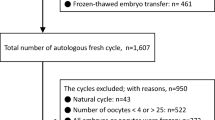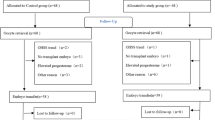Abstract
Purpose: To evaluate the effect of the GnRH antagonist, ganirelix acetate, on oocyte quality. Methods: Stimulation characteristics, implantation rates and clinical pregnancy rates were compared between 29 oocyte donors 21–31 years of age who underwent 31 cycles of ovarian stimulation with gonadotropins and ganirelix acetate, and 36 infertile couples of similar age range who underwent 51 cycles of ovarian stimulation using the same protocol. Results: A significantly lower number of embryos were transferred in the donor/recipient group as compared to the infertile group (2.32±0.54 vs. 2.82±0.71, P<0.05). In contrast, implantation and clinical pregnancy rates per transfer, were significantly higher in the donor/recipient group (38.1% vs. 10.4%, P<0.01) and (61.3% vs. 23.1%, P<0.05) respectively, as compared to the infertile group. Conclusions: Incorporation of ganirelix acetate for pituitary suppression in stimulation protocols for oocyte donation is associated with high pregnancy rates suggesting that ganirelix acetate does not exert an adverse effect on oocyte or embryo quality.
Similar content being viewed by others
References
Porter RN, Smith W, Craft IL, Abdulwahid NA, Jacobs HS (1984) Induction of ovulation for in-vitro fertilisation using buserelin and gonadotropins. Lancet 2(8414):1284–1285
Shaw RW, Ndukwe G, Imoedemhe DA, Bernard AG, Burford G (1985) Twin pregnancy after pituitary desensitisation with LHRH agonist and pure FSH. Lancet 2(8453):506–507
Ben-Rafael Z, Lipitz S, Bider D, Mashiach S (1991) Ovarian hyporesponsiveness in combined gonadotropin-releasing hormone agonist and menotropin therapy is associated with low serum follicle- stimulating hormone levels. Fertil Steril 55(2):272–275
Diedrich K, Diedrich C, Santos E, Zoll C, al-Hasani S, Reissmann T et al (1994) Suppression of the endogenous luteinizing hormone surge by the gonadotrophin-releasing hormone antagonist Cetrorelix during ovarian stimulation. Hum Reprod 9(5):788–791
Albano C, Smitz J, Camus M, Riethmuller-Winzen H, Van Steirteghem A, Devroey P (1997) Comparison of different doses of gonadotropin-releasing hormone antagonist Cetrorelix during controlled ovarian hyperstimulation. Fertil Steril 67(5):917–922
Olivennes F, Fanchin R, Bouchard P, Taieb J, Selva J, Frydman R (1955) Scheduled administration of a gonadotrophin-releasing hormone antagonist (Cetrorelix) on day 8 of in-vitro fertilization cycles: a pilot study. Hum Reprod 10(6):1382–1386
Albano C, Felberbaum RE, Smitz J, Riethmuller-Winzen H, Engel J, Diedrich K et al (2000) Ovarian stimulation with HMG: results of a prospective randomized phase III European study comparing the luteinizing hormone-releasing hormone (LHRH)-antagonist cetrorelix and the LHRH-agonist buserelin. European Cetrorelix Study Group. Hum Reprod 15(3):526–531
Borm G, Mannaerts B (2000) Treatment with the gonadotrophin-releasing hormone antagonist ganirelix in women undergoing ovarian stimulation with recombinant follicle stimulating hormone is effective, safe and convenient: results of a controlled, randomized, multicentre trial. The European Orgalutran Study Group. Hum Reprod 15(7):1490–1498
Olivennes F, Belaisch-Allart J, Emperaire JC, Dechaud H, Alvarez S, Moreau L et al (2000) Prospective, randomized, controlled study of in vitro fertilization- embryo transfer with a single dose of a luteinizing hormone-releasing hormone (LH-RH) antagonist (cetrorelix) or a depot formula of an LH-RH agonist (triptorelin). Fertil Steril 73(2):314–320
Al-Inany H, Aboulghar M (2001) Gonadotrophin-releasing hormone antagonists for assisted conception. Cochrane Database Syst Rev 4
Fluker M, Grifo J, Leader A, Levy M, Meldrum D, Muasher SJ et al (2001) Efficacy and safety of ganirelix acetate versus leuprolide acetate in women undergoing controlled ovarian hyperstimulation. Fertil Steril 75(1):38–45
Filicori M, Cognigni GE, Tabarelli C, Pocognoli P, Taraborrelli S, Spettoli D, et al (2002) Stimulation and growth of antral ovarian follicles by selective LH activity administration in women. J Clin Endocrinol Metab 87(3):1156–1161
Filicori M, Cognigni GE, Taraborrelli S, Spettoli D, Ciampaglia W, Tabarelli De Fatis C, et al (2001) Luteinzing hormone activity in menotropins optimizes folliculogenesis and treatment in controlled ovarian stimulation. J Clin Endocrinol Metab 86(1):337–343
Fraser HM, Lunn SF, Morris KD, Deghenghi R (1997) Initiation of high dose gonadotrophin-releasing hormone antagonist treatment during the late follicular phase in the macaque abolishes luteal function irrespective of effects upon the luteinizing hormone surge. Hum Reprod 12(3):430–435
Kolibianakis E, Bourgain C, Albano C, Osmanagaoglu K, Smitz J, Van Steirteghem A et al (2002) Effect of ovarian stimulation with recombinant follicle-stimulating hormone, gonadotropin releasing hormone antagonists, and human chorionic gonadotropin on endometrial maturation on the day of oocyte pick-up. Fertil Steril 78(5):1025–1029
Tavaniotou A, Albano C, Smitz J, Devroey P (2002) Impact of ovarian stimulation on corpus luteum function and embryonic implantation. J Reprod Immunol 55(1–2):123–130
Noyes RW, Hertig AT, Rock J (1975) Dating the endometrial biopsy. Am J Obstet Gynecol 122(2):262–263
Garcia JE, Acosta AA, Hsiu JG, Jones HW Jr (1984) Advanced endometrial maturation after ovulation induction with human menopausal gonadotropin/human chorionic gonadotropin for in vitro fertilization. Fertil Steril 41(1):31–35
Chetkowski RJ, Kiltz RJ, Salyer WR (1997) In premature luteinization, progesterone induces secretory transformation of the endometrium without impairment of embryo viability. Fertil Steril 68(2):292–297
Anonymous (2002) Guidelines for oocyte donation. Fertil Steril 77(6 Suppl 5):S6–S8
Kol S (2000) Embryo implantation and GnRH antagonists: GnRH antagonists in ART: lower embryo implantation? Hum Reprod 15(9):1881–1882
Das K, Stout LE, Hensleigh HC, Tagatz GE, Phipps WR, Leung BS (1991) Direct positive effect of epidermal growth factor on the cytoplasmic maturation of mouse and human oocytes. Fertil Steril 55(5):1000–1004
Dekel N, Sherizly I (1985) Epidermal growth factor induces maturation of rat follicle-enclosed oocytes. Endocrinology 116(1):406–409
Hernandez ER (2000) Embryo implantation and GnRH antagonists: embryo implantation: the Rubicon for GnRH antagonists. Hum Reprod 15(6):1211–1216
Cross JC, Werb Z, Fisher SJ (1994) Implantation and the placenta: key pieces of the development puzzle. Science 266(5190):1508–1518
Hershkovitz E, Marbach M, Bosin E, Levy J, Roberts CT Jr, LeRoith D et al (1993) Luteinizing hormone-releasing hormone antagonists interfere with autocrine and paracrine growth stimulation of MCF-7 mammary cancer cells by insulin-like growth factors. J Clin Endocrinol Metab 77(4):963–968
Kleinman D, Roberts CT Jr, LeRoith D, Schally AV, Levy J, Sharoni Y (1993) Regulation of endometrial cancer cell growth by insulin-like growth factors and the luteinizing hormone-releasing hormone antagonist SB-75. Regul Pept 48(1–2):91–98
Minaretzis D, Jakubowski M, Mortola JF, Pavlou SN (1995) Gonadotropin-releasing hormone receptor gene expression in human ovary and granulosa-lutein cells. J Clin Endocrinol Metab 80(2):430–434
Del Gadillo JC, Siebzehnrubl E, Dittrich R, Wildt L, Lang N (2002) Comparison of GnRH agonists and antagonists in unselected IVF/ICSI patients treated with different controlled ovarian hyperstimulation protocols: a matched study. Eur J Obstet Gynecol Reprod Biol 102(2):179–183
Olivennes F (2002) GnRH antagonists: do they open new pathways to safer treatment in assisted reproductive techniques? Reprod Biomed Online 5(Suppl 1(3)):20–25
Olivennes F, Cunha-Filho JS, Fanchin R, Bouchard P, Frydman R (2002) The use of GnRH antagonists in ovarian stimulation. Hum Reprod Update 8(3):279–290
Albano C, Smitz J, Tournaye H, Riethmuller-Winzen H, Van Steirteghem A, Devroey P (1999) Luteal phase and clinical outcome after human menopausal gonadotrophin/gonadotrophin releasing hormone antagonist treatment for ovarian stimulation in in-vitro fertilization/intracytoplasmic sperm injection cycles. Hum Reprod 14(6):1426–1430
Lewin A, Benshushan A, Mezker E, Yanai N, Schenker JG, Goshen R (1994) The role of estrogen support during the luteal phase of in vitro fertilization-embryo transplant cycles: a comparative study between progesterone alone and estrogen and progesterone support. Fertil Steril 62(1):121–125
Itskovitz-Eldor J, Kol S, Mannaerts B (2000) Use of a single bolus of GnRH agonist triptorelin to trigger ovulation after GnRH antagonist ganirelix treatment in women undergoing ovarian stimulation for assisted reproduction, with special reference to the prevention of ovarian hyperstimulation syndrome: preliminary report: short communication. Hum Reprod 15(9):1965–1968
Kol S, Itskovitz-Eldor J (2000) Severe OHSS: yes, there is a strategy to prevent it! Hum Reprod 15(11):2266–2267
Author information
Authors and Affiliations
Corresponding author
Additional information
Capsule: Incorporation of ganirelix acetate in stimulation protocols for oocyte donation is associated with high pregnancy rates suggesting that there is no adverse effect on oocyte quality
Rights and permissions
About this article
Cite this article
Vlahos, N.F., Bankowski, B.J., Zacur, H.A. et al. An oocyte donation protocol using the GnRH antagonist ganirelix acetate, does not compromise embryo quality and is associated with high pregnancy rates. Arch Gynecol Obstet 272, 1–6 (2005). https://doi.org/10.1007/s00404-005-0726-2
Received:
Accepted:
Published:
Issue Date:
DOI: https://doi.org/10.1007/s00404-005-0726-2




